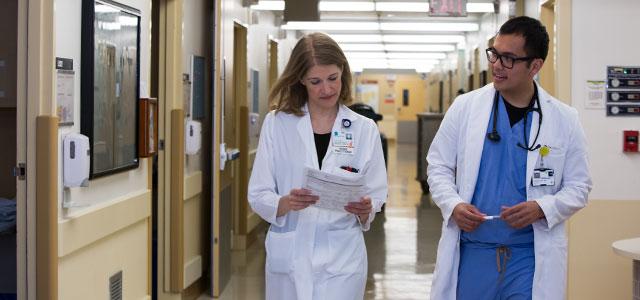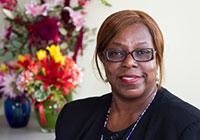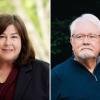
Nurse practitioners Kerry Decker and Archie Garino at UCSF Medical Center’s liver transplant service (photo by Elisabeth Fall)
New Roles for Nurse Practitioners Bring Opportunities and Challenges
Over the past decade, a confluence of events – including the Affordable Care Act, new education requirements for health care providers and the increasing clinical complexity of the patient population – has been rearranging the health care system in the US. This evolution has placed an increasing focus on the value of nurse practitioners (NPs) and other advanced practice providers, such as physician assistants, certified registered nurse anesthetists and midwives. It has also spurred a redefining of roles, which brings both new challenges and opportunities for providers and health systems.
Much of the media focus has been on how NPs can help reduce the so-called “primary care gap,” but the need for an increasingly flexible and well-trained clinician workforce practicing to the top of their scope is much broader, says Sheila Antrum, president of UCSF Medical Center and current chief nursing officer. There are several reasons for this, she says.
One is restrictions imposed on medical resident work hours, which created higher shift turnover among residents in academic medical centers, where the most complex patients often receive care. In acute care settings, NPs can provide continuous high-level care, thus smoothing transitions between providers and reducing the potential for error.
Another related reason is the need for better communication and collaboration among disciplines and from shift to shift. A series of seminal Institute of Medicine reports over several decades has highlighted the importance of clinicians working in interdisciplinary teams to cross what they termed the “quality chasm” and improve outcomes for all patients.
NPs are perhaps uniquely suited to facilitating interdisciplinary collaboration, says Antrum. “They are very good at getting and telling the full story,” she says. “They understand the continuum of care, they have good relationships with bedside nurses, and they tend to be at the bedside more [than physicians], collaborating with the care team.”
Kerry Decker, a nurse practitioner on UCSF Medical Center’s liver transplant service, agrees. “It’s essential for patient care to not have things lost in translation,” she says. “NPs are experts in communicating concerns of the patient, nurse or physician to each other, and better communication can help the team facilitate the best plan.”
Easing Transitions and Increasing Efficiency
Another impetus for expanding the use of nurse practitioners is efficiency, in both cost and work flow.
In the primary care setting, the value seems obvious: NPs, who cost far less to train than do physicians, are educated and credentialed to meet most preventive and chronic care needs of a primary care patient population. But because NPs’ training and scope of practice include care that registered nurses (RNs) aren’t trained or licensed to provide, such as writing orders and prescribing medication, NPs can also increase efficiency in the acute care setting by bridging gaps – between more and less complex care, between nursing and medical staff, across different hospital services – and by easing the often-difficult transition between in- and outpatient care.
Antrum cites an example from the UCSF Medical Center in which a service caring for some of the most complex patients – neurosurgery – hired an NP to coordinate weekend discharges for its patients, a trend she says is increasing around the country. Traditionally, coordinating discharge of patients from the hospital has been a role for RNs, social workers or case managers, with supervision from physicians. By hiring an NP, the unit was able to free more nurses to focus on bedside care and physicians to focus on more complex care and surgical needs of patients. It also provided a smoother, better-coordinated discharge experience for patients and their families.
 Sheila Antrum The result was a more efficient discharge system overall and better turnover of beds (between 10 and 15 percent higher over weekends worked by the NP, according to Antrum), benefiting both patients – who get out of the hospital and away from its attendant irritations and risks – and the unit, which loses reimbursement when patients exceed their necessary length of stay. More efficient discharge also translated to more neurosurgery cases getting done as scheduled rather than postponed due to lack of bed capacity, a win for everyone. “If I were czar, I’d have a discharge NP on every service,” says Antrum.
Sheila Antrum The result was a more efficient discharge system overall and better turnover of beds (between 10 and 15 percent higher over weekends worked by the NP, according to Antrum), benefiting both patients – who get out of the hospital and away from its attendant irritations and risks – and the unit, which loses reimbursement when patients exceed their necessary length of stay. More efficient discharge also translated to more neurosurgery cases getting done as scheduled rather than postponed due to lack of bed capacity, a win for everyone. “If I were czar, I’d have a discharge NP on every service,” says Antrum.
A Continuum of Care
Another potential role for NPs is facilitating care that crosses the divide between in- and outpatient care. Antrum notes that some services at the medical center, such as general surgery, are looking at implementing models in which NPs follow patients through the continuum of care, from outpatient clinic to inpatient stay and through discharge back to clinic for follow-up.
Antrum says, “Care gets more efficient because you have a person who’s navigated with you from beginning to end, and it’s a patient satisfier because they see the same face in clinic and the hospital.”
The advent of accountable care organizations (ACOs) has also seen NPs playing new hybrid roles in the community, both seeing patients and coordinating care for patients across the ACO’s services and providers, says Antrum. “It’s a transitional role, with the NP overseeing a home health strategy or a skilled nursing strategy, determining the best place to send the patient for rehab. Because they can write orders, they can move the case along,” she says.
Moreover, Antrum asserts, as patients enter an ACO-affiliated hospital, NPs can play a triage role, which can, in theory, serve patients, reduce costs and improve efficiency.
“No hospital can provide care for every patient, so we have to say, ‘Is this the best place for the patient with the resources we have?’ That can start with the NP because he or she knows the system and can advise the referring physician,” she says. Trust is a crucial factor. “People get things done through relationships. Whether it’s the patient with the provider or the facility with the referring physician, you have to have a linkage of trust, and I think that’s what NPs can provide.”
All of these emerging roles translate to new opportunities for NPs, who have more choices than ever in terms of the kinds of practice they want to enter. The US Bureau of Labor Statistics projects a 31 percent increase in employment for NPs, certified nurse-midwives and certified nurse anesthetists from 2014 to 2024, far higher than the average for all occupations. UCSF Medical Center currently employs more than 300 NPs, says Antrum, with 38 vacancies as of the writing of this article.
A Need for More Specialized Training
One of the challenges in filling these vacancies, however, is the need to find NPs with the practical skills and experience to manage complex patients with special needs on units like neurosurgery, the intensive care units (ICUs) and transplant services. While NPs get a minimum of 500 clinical hours during training, these hours are spread across a variety of areas, which may not adequately prepare them to work in highly specialized and complicated services when they are just out of training. “Six or seven years ago, when the acuity wasn’t as high, it worked,” says Antrum. “But it won’t work in today’s world. You’re going to burn people out.”
The transplant service is an example, says Decker. Physicians were eager to hire NPs, but they felt NPs coming out of school didn’t have the specialized knowledge and skills they needed, and it took too long to get them up to speed in the fast-paced, high-acuity environment. “There was high turnover,” Decker says. “NPs would get discouraged entering these roles with an enormous learning curve, and other providers would be frustrated with the time it took for them to get up to speed. You have to be given the support to acquire the knowledge to take care of these critically ill patients.”
Looking for New Training Models
 These types of demands led to the medical center and UCSF School of Nursing working together and in parallel to better meet the demands.
These types of demands led to the medical center and UCSF School of Nursing working together and in parallel to better meet the demands.
Six years ago, Antrum and a group of 15 advanced health practitioners formed a board that, among other activities, developed a process to help identify and promote NPs with demonstrated clinical expertise and the skills to thrive in an academic environment. Candidates are assessed according to rigorous criteria and interviews. Those selected, designated nurse practitioner 3 (NP 3), are considered capable of managing a higher level of clinical, research and teaching responsibility.
Decker, who was among the first cohort of NP-3 designees, has become a champion for increasing clinical training opportunities for recent NP graduates. In 2014, with Thomas Farley, an NP in the UCSF Medical Center ICU and a clinical instructor in the School’s Adult-Gerontology Acute Care Nurse Practitioner Program, she co-created the UCSF Surgical and Critical Care Nurse Practitioner Fellowship. The fellowship allows a graduate of an accredited acute care geriatric NP program to rotate through surgery and critical care services, providing direct patient care while receiving additional didactics in each area. It also provides opportunities to take extra courses, such as an ultrasound workshop, to help them build skills specific to acute and critical care work.
Over the fellowship year, says Decker, fellows receive about 2,000 additional training hours beyond what they received in school. While that’s incredibly valuable, perhaps the key piece of the fellowship, she adds, is the close mentorship fellows get with an NP on each service rotation. “The idea is that you aren’t thrown in where you don’t have support. You gradually increase your knowledge and patient load, and sample different services to see what patient population you might enjoy working with long-term,” she says.
The first fellow completed the program last year and is working at UCSF Medical Center on the kidney transplant service after having received three job offers. A second NP graduate is several months into the fellowship. The fellowship is currently applying for practice transition program accreditation from the American Nurses Credentialing Center (ANCC), which would make it only the third accredited advanced practice registered nurse (APRN) fellowship in the US, and there are plans to expand the program to five fellows per year.
There is, however, a problem, says Decker, in that it is difficult to find enough preceptors to teach and mentor potential fellows. It’s not a lack of desire to teach, she says, but a perceived lack of time, particularly in the fast-paced environments of acute and critical care. She adds, however, “It’s important to note that the fellow, unlike an NP student, is a fully licensed provider, so they’re taking on a real patient load. Mentorship is different from supervision.”
Defining Roles and Educating Staff
As roles for advanced health practitioners change and expand, an additional challenge for organizations like the UCSF Medical Center is figuring out exactly how to define these roles and ensure accountability, not just for the practitioners, but for the other staff who will be asked to form effective collaborative relationships with them, and who may be unfamiliar with their skills, values and needs.
At UCSF, Antrum and her colleagues are recruiting for a new position, director of advanced health, to help manage the changes. Antrum envisions several initial goals for whoever is selected: to create a thriving community for all advanced health practitioners at the medical center, to educate both clinical and nonclinical staff about the roles of advanced health practitioners and to increase advanced health practitioner engagement in UCSF Health.
Antrum is hopeful that the expansion of roles for advanced health practitioners will create synergies that will continue to benefit both patients and practitioners beyond the hospital and clinics. She says, “The work advanced health practitioners do will continue to demonstrate and increase their value at UCSF Health.”



